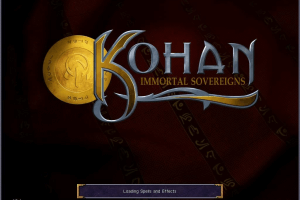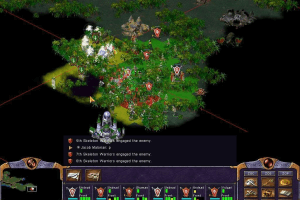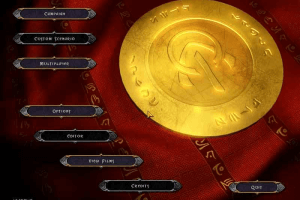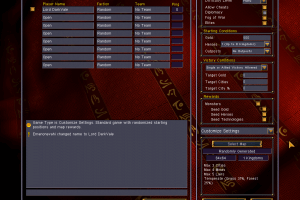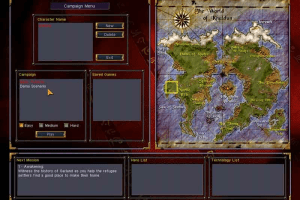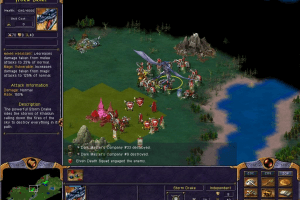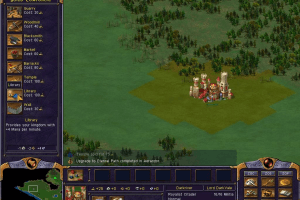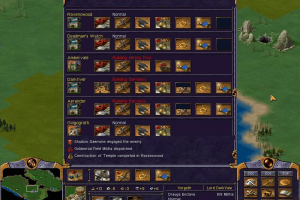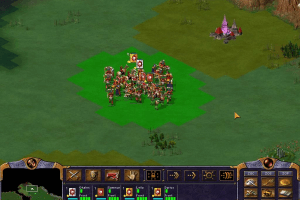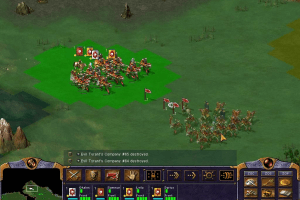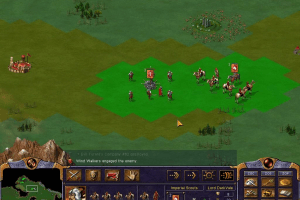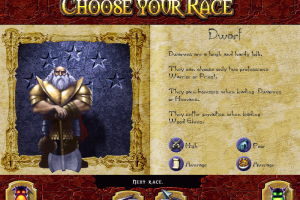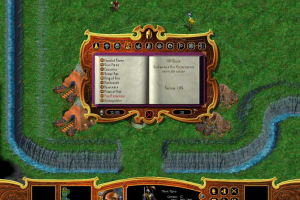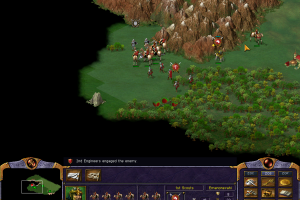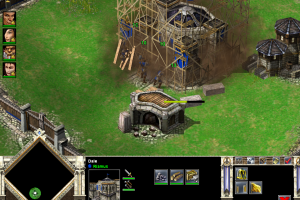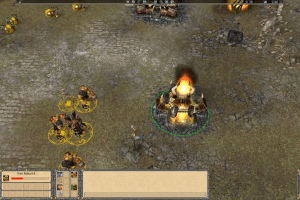Kohan: Immortal Sovereigns
Windows - 2001
Also released on: Linux
Description of Kohan: Immortal Sovereigns
Without a doubt, Kohan: Immortal Sovereigns is the best real-time strategy game I have played since Enlight's underrated Seven Kingdoms II, hands-down.
At first glance, Kohan appears to be another run-of-the-mill RTS game in the footsteps of StarCraft. It is played from a top-down view, where you order units to build structures and attack enemies. Many familiar commands such as, "Attack", "Stop", and "Move" are here. Fortunately for us gamers, this is the point after which all similarities cease. After playing Kohan for several minutes, you will discover many elements that are normally found in more traditional, turn-based strategy games. And after your first battle, you will realize that Kohan is something special indeed.
Like many other RTS, Kohan takes place in fantasy realm. The game takes place in the mystical land of Khaldun, where an immortal race of demi-humans called Kohan once ruled over the masses. Through a series of great cataclysms, much of their society was destroyed, and lesser humans began to overtake the lands. Eons down the road, a great evil begins to awaken. Known only as the Shadow, this dark force threatens to tear apart the world of Khaldun. At the same time the Shadow began to stir, the Kohan started appearing once again: some siding with the forces of light, and others choosing to follow the Shadow. Your duty as one of these immortal beings is using your powers to discover the reason behind the downfall of the Kohan and bring the end to the Shadow's evil scheme.
While Kohan follows the familiar collect-resources-to-expand-empire formulae of most RTS games, it doesn't focus as much on resource management as other games. You won't see peasants chopping up wood and harvesting livestock here - instead, Kohan uses an abstract, virtually transparent economic model (similar to Imperialism). Resources such as gold, iron, and wood are collected automatically from cities under your control. Depending on the size of your cities, each location will take in (and spend) a certain amount of gold in taxable revenue. With a balanced economy, gold reserves will slowly increase until reaching a maximum level for stockpiling. The bonuses you gain for founding new settlements gives rise to the most interesting feature that not only sets Kohan far apart from all other RTS games: the concept of zones.
Zones in Kohan are similar to the zones in SimCity 2000, and are also roughly equivalent to the idea of "supply radius" in traditional wargames. A zone is a circle radiating out from your cities and outposts depending on their size and status. There are three types of zones, the most important of which is the "Zone of Supply" (ZOS). While your troops are resting within the ZOS, they are automatically healed and replenished to full strength over time. Since this works during battles, it is vital to know where your ZOS lies, and engaging enemies within this radius can spell the difference between defeat and victory. The second type of zone is called "Zone of Control", which determines where you can place new settlements. Finally, there is the "Zone of Command" (ZOC), which is far more complex than the other two. A ZOC is a small area surrounding your troops which indicates the areas over which they have "influence", and this determines when actions or events can be triggered. For example, to have them resupplied, you must move the units so that their ZOC overlaps with a Zone of Supply. When two opposing armies' ZOCs overlap, they will automatically initiate combat.
Another way in which Kohan distinguishes itself from the RTS crowd is the way armies are managed, which is both interesting and challenging. Units in the game are organized into groups called companies. All companies comprise of four primary units and one leader, with two optional support units flanking each side. The leader slot is where you place immortal Kohan heroes. Having a hero as leader of one company will enhance it with various attributes and even powerful spells if that hero is a magic user. As heroes fight through the campaigns, they will gain levels and become more powerful through experience. Companies can be assembled from many types of units, including ranged, melee, magical, mundane, and defensive. Companies can also make up of non-combat units, such as engineers and settlers. The radius of ZOC even changes depending on the type of terrain it is on. For instance, the size of ZOC when a company is trudging through deserts is much smaller than when it travels over plains?reflecting the real-life effect of lower visibility in deserts. Terrain also affects the speed your companies can travel, as well as combat modifiers.
Combat in Kohan is an enjoyable affair that is much deeper than it appears. You can order your companies to use several different formations, each of which offers a unique balance between speed and combat effectiveness. Once your troops are engaged in combat (i.e. after their ZOC overlaps with an enemy's), there is rarely a need for you to intervene - thanks to the exceptional AI in Kohan. Infantry run toward their closest target, clerics heal the most damaged soldiers, and wizards cast lighting bolts with deadly accuracy. No need to frantically click on targets to change orders - all you need to do is sit back and watch as your tactic is put to action. As companies take damage and their morale drop, they will often automatically retreat from combat. If the morale drops too low, you will lose the ability to tell the companies where exactly to retreat. In these circumstances, you can only tell it to "rout" and the company will flee to a random location, hopefully far from enemy ambushes.
As if the innovations aren't enough, Kohan packs an excellent single-player campaign modes, the usual plethora of multiplayer options (up to 8 players can join a game), and even an excellent mission editor. There's even a cool backstory that develops into a semi-epic in single player campaign, and some of the best tutorial missions I have ever seen. As of this writing (August 2001), Kohan is the most addictive game I have played in a long time - and that's saying a lot. By far, a must-have for every RTS fan, and an entrant to our hallowed Hall of Belated Fame, without a doubt.
Review By HOTUD
External links
Captures and Snapshots
Comments and reviews
YungPigy 2024-11-25 0 point
Hi so i did some research and the deal is that the studio who had rights for this game went bankrupt essentialy when steam started working back in 2011 or something so they didnt change the option for adding other currencies for these games so only people in UK and US can buy this game, you can buy this game on steam for pounds or dollars, and steam cant do anything game is in license limbo, no one knows who has rights to series or at least i dont know, or if they plan to add option for adding other currencies, so basically rest of the world cant buy this game without changing there county and currency, so please add this back to this site, all three games.
cheers!
paulwratt 2023-12-06 0 point Windows version
I bought the Kohan Warchest on steam (not sure when, its still on sale now, contains all 3 games) but I never played it until now, and for the life of me, I can not find the CD keys for it .. (digital or otherwise)
Write a comment
Share your gamer memories, give useful links or comment anything you'd like. This game is no longer abandonware, we won't put it back online.
Buy Kohan: Immortal Sovereigns
Kohan: Immortal Sovereigns is available for a small price on the following website, and is no longer abandonware. You can read our online store guide.
Other Releases
Kohan: Immortal Sovereigns was also released on the following systems:
Linux
- Year: 2001
- Publisher: Loki Entertainment Software, Inc.
- Developer: TimeGate Studios, Inc.
Similar games
Fellow retro gamers also downloaded these games:

